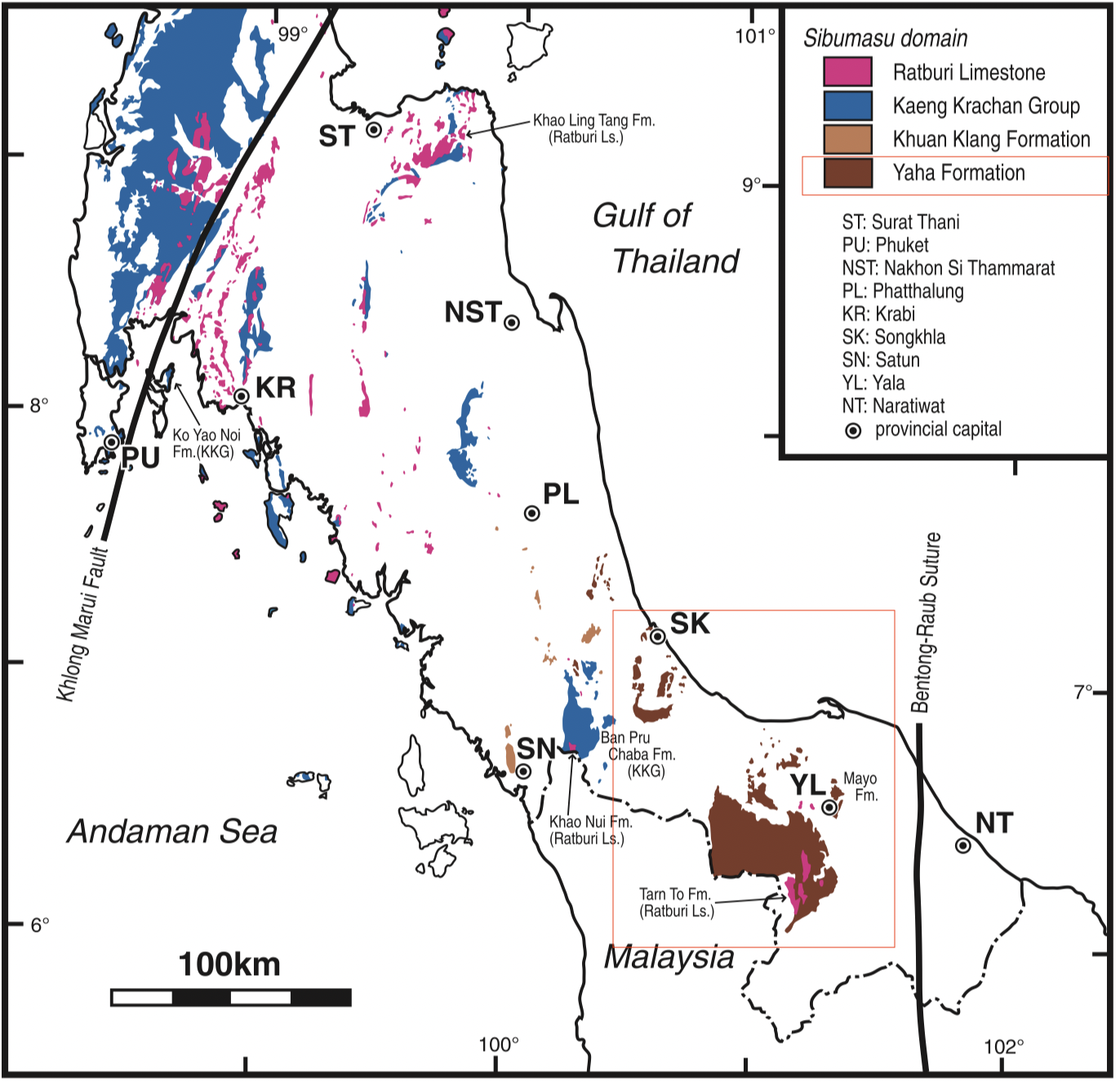Type Locality and Naming
8 km south of Yaha district, Yala province.
Remarks: This formation was previously mapped as part of the Kaeng Krachan Gr. The name was introduced by Muenlek et al. (1985) in the Geological Map of Changwat Narathiwat and Amphoe Takbai for a mainly siliciclastic succession of shale, medium- to coarse-grained sandstone, siliceous shale, chert and conglomerate. On the same geological map, Muenlek et al. (1985) also introduced the Mayo Fm for similar siliciclastic strata NE of Yala and included both formations in the Kaeng Krachan Gr with the Mayo Fm in the lower part and the Yaha Fm in the upper. The DMR (1999) does not distinguish the Mayo Fm from the Yaha Fm and maps the latter formation in Yala, Pattani, Songkhla and Phatthalung provinces and assigns it to the Carboniferous (Ueno & Charoentitirat, 2011).
Synonym: หมวดหินยะหา
Lithology and Thickness
Litho- and chronostratigraphic characterization of the Yaha Formation is very controversial. Mainly siliciclastic succession of shale, medium- to coarse-grained sandstone, siliceous shale, chert and conglomerate
. Thickness: 400-450 m (Amnan and Raksaskulwong, 2002)
GeoJSON
{"type":"Feature","geometry":{"type":"MultiPolygon","coordinates":[[[[99.37,9.2],[99.66,9.37],[99.89,9.32],[100.16,8.78],[100.39,7.93],[100.58,6.98],[100.57,6.39],[100.32,6.3],[99.81,6.7],[99.24,7.45],[98.82,8.18],[99.08,8.51],[99.37,9.2]]]]}}
Fossils
Quote from Ueno & Charoentitirat (2011): A Mississippian age for the Yaha Formation was substantiated by late Tournaisian conodonts from a chert and siliceous shale succession at the northern end of Ko Yo in Songkhla Province (Igo 1973). Grant-Mackie et al. (1980) regarded the chert-siliceous shale beds as a component of the Songkhla Sandstone, although they are essentially different in lithofacies. Moreover, it is important to note the occurrence of another Mississippian (Tournaisian) radiolarian fauna from siliceous shale blocks in a quarry to the east of Na Thawi in Songkhla Province (Sashida et al. 2000b), exposing strongly sheared alternating beds of sandstone and shale with sandstone and siliceous shale blocks. Sashida et al. (2000b) originally assigned the strata to the Wang Yai Siltstone of Grant-Mackie et al. (1980). From their studies straddling the Malaysian–Thai border, Ibrahim bin Amnan & Raksaskulwong (2002) included the strata from which the Mississippian radiolarians were obtained by Sashida et al. (2000b) in the Yaha Formation. More recently, Sashida et al. (2002) reported a Mississippian (Tournaisian) radiolarian fauna from a sandstone-chert succession (mapped by the DMR 1999 as the Yaha Formation) exposed in the Saba Yoi–Kabang area near the Songkhla–Yala provincial boundary.
Age
Carboniferous (?) (Muenlek and others, Carboniferous (Amnan and Raksaskulwong, 2002); " We therefore regard the Yaha Formation only provisionally as Mississippian." (Ueno & Charoentitirat, 2011). [For graphic purposes, placed here in upper Tournaisian, above the Khuan Klang Fm.]
Additional Information
Apart from those Mississippian fossils, Late Permian and Middle Triassic radiolarians have also been reported from two areas that were mapped as the Yaha Formation by the DMR (1999): the Chana area (Sashida et al. 2000b) and the Rattaphum area (Sardsud & Saengsrichan 2002; Kamata et al. 2008, 2009), both in Songkhla Province. Particularly, Middle Triassic radiolaria-bearing bedded chert of the Rattaphum area is interpreted as hemipelagic chert probably formed on a continental margin of the Sibumasu Block (Kamata et al. 2006, 2009). In most areas, however, the Yaha Formation remains poorly dated. Although Mississippian microfossils occur in some places in siliceous rocks of the Yaha Formation as noted above, the formation itself, at least partly, could be post-Carboniferous based on the occurrences of both Carboniferous radiolaria-bearing blocks in siliciclastic matrices and Permian-Triassic radiolarians from chert and shale beds.
Compiler:
Wen Du - modified from Katsumi Ueno & Thasinee Charoentitirat, 2011, Chapter5 Carboniferous and Permian in: Ridd, M.F., Barber, A.J., and Grow, M.J., editors,
The Geology of Thailand, Geol. Soc. of London;
Lexicon of Stratigraphic Names of Thailand of 2013.
